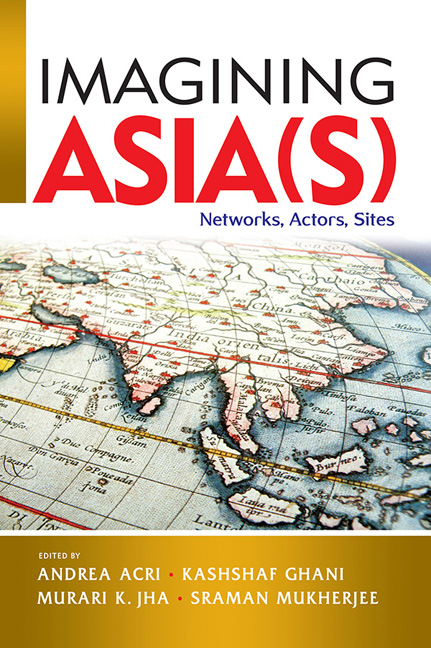Book contents
- Frontmatter
- Contents
- List of Contributors
- Introduction
- Part I Conceptualizing the Region: Past and Present
- Part II Conceptualizing Asia through the Prism of Europe
- Part III Networks of Knowledge Across the Indian Ocean
- Part IV Histories and Geographies of Pilgrimage in Asia
- Part V Trans-Local Dynamics and Intra-Asian Connections across Space and Time
- 10 Sanskritic Buddhism as an Asian Universalism
- 11 Interconnectedness and Mobility in the Middle Ages/Nowadays: From Baghdad to Chang'an and from Istanbul to Tokyo
- 12 Connecting Networks and Orienting Space: Relocating Nguyen Cochinchina between East and Southeast Asia in the Sixteenth and Eighteenth Centuries
- 13 The Highlands of West Sumatra and their Maritime Trading Connections
- Index
12 - Connecting Networks and Orienting Space: Relocating Nguyen Cochinchina between East and Southeast Asia in the Sixteenth and Eighteenth Centuries
from Part V - Trans-Local Dynamics and Intra-Asian Connections across Space and Time
Published online by Cambridge University Press: 31 January 2020
- Frontmatter
- Contents
- List of Contributors
- Introduction
- Part I Conceptualizing the Region: Past and Present
- Part II Conceptualizing Asia through the Prism of Europe
- Part III Networks of Knowledge Across the Indian Ocean
- Part IV Histories and Geographies of Pilgrimage in Asia
- Part V Trans-Local Dynamics and Intra-Asian Connections across Space and Time
- 10 Sanskritic Buddhism as an Asian Universalism
- 11 Interconnectedness and Mobility in the Middle Ages/Nowadays: From Baghdad to Chang'an and from Istanbul to Tokyo
- 12 Connecting Networks and Orienting Space: Relocating Nguyen Cochinchina between East and Southeast Asia in the Sixteenth and Eighteenth Centuries
- 13 The Highlands of West Sumatra and their Maritime Trading Connections
- Index
Summary
“For the western direction, there is no road to reach it
For the northern direction, it is so difficult to go there.
For the southern direction, it is visible.
The only fear is the Da Vach [highlanders].”
Nguyen Cu Trinh (1750, p. 56)INTRODUCTION: PROBLEMS OF SPATIAL ORIENTATION IN VIETNAMESE HISTORY
History was born when some specific times and places were connected. While the spatial frame defines historical experience, the agents who act in time and space give meaning to history. Approaches to the evolution of Vietnamese geography mostly concentrate on the internal structure of the historically mobile spaces in which the relationship between movement and imagination constructs the recognizable configuration of Vietnam. Keith Taylor's pattern of regional conflict and Li Tana's new way of conceptualizing Vietnam target the “Southeast Asian character” of Cochinchina, in contrast to the Sinicized Tonkin (Taylor 1998; Li 1998a). Victor Lieberman borrows Pierre Gourou's terminology to describe the Vietnamese coast as “the least coherent territory in the world” (Gourou 1936, p. 8; Lieberman 2003, p. 338). Nola Cooke (1991, 1995) and Choi Byung Wook (2004) recommend the process of political centralization and Confucianization under which modern Vietnamese states recognized the territorial status of the lower Mekong. The above-mentioned scholars aim to demonstrate the “Southeast Asian” cultural factors in the making of Vietnam, and in so doing, they challenge the conventional monotonous narrative of national unification offered by twentieth century nationalist historiography. This historiography has played down, for the interest of nationalism, Cochinchinese autonomy while defining the Sinicized North as a touchstone of historical evolution through the mythic discourse of nam tien or “marching to the south” as a territorial “manifest destiny”.
Another side of the coin, however, are the scholars who conceptualize Cochinchina as an “East Asian style” political project that settled in “Southeast Asian” landscape. One particular aspect of the Nguyen Cochinchina that has been tackled recently is Confucianism. Historian Liam Kelley challenges previous assumptions suggesting that the Nguyen “differentiated themselves from their own ancestral people in the north in order to secure their own political survival” because the Confucian repertoire was inappropriate for the southern political project (Li 1998b, p. 101).
- Type
- Chapter
- Information
- Imagining Asia(s)Networks, Actors, Sites, pp. 358 - 392Publisher: ISEAS–Yusof Ishak InstitutePrint publication year: 2019

